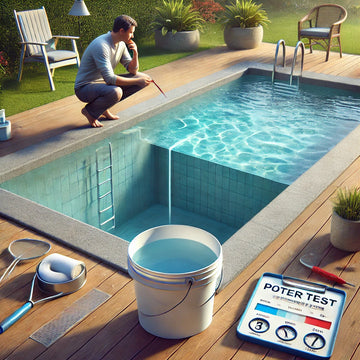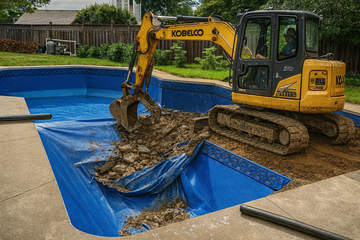HOW TO DETERMINE THE CAUSE OF POOL WATER LOSS
Many pool owners are afraid their pool water loss problems might be due to a pool leak while it is, in fact, due to evaporation.
A lot of factors can be the cause of evaporation and pool water loss. So before you assume the worst, consider this guide on pool evaporation and pool leaks to determine what is the actual cause of your water loss and how you can prevent pool evaporation.
WHAT IS EVAPORATION?
Evaporation occurs when a liquid turns into vapour. And when it comes to pool water, evaporation occurs when the water is exposed to air, wind, and sunlight.
During evaporation, water molecules rise to the surface, form into a vapour, and get released into the air.
SO, POOL LEAK OR EVAPORATION?
There are three main causes of pool evaporation.
HUMIDITY
A lack of humidity or moisture in the air will cause more water to evaporate from your pool.
The drier the heat and air, the more water will be sucked up into the air like with a towel or sponge. On the other hand, if you live in an area with high humidity, then your pool will lose less water.
TEMPERATURE
Summer heat is a major cause of water evaporation. And if temperatures are high during the day and cool at night, the difference in temperature between the pool water and outside air will cause even more evaporation. This is why heated pools tend to lose more water to evaporation overnight.
EXPOSURE
Pools that are fully exposed to the sun and wind will lose more water to evaporation than pools that are covered when not in use.
Along with pool covers, structures, fences, and trees can also shade the pool and block the wind to help prevent evaporation.
LEAK OR EVAPORATION: METHOD DETECTION
Water loss of a ¼ inch to a ½ inch per day is normal. More than an inch per day is likely due to a leak.
Here are the common methods pool experts use for determining whether water loss is due to a leak or evaporation.
THE BUCKET TEST
- Place a 5-gallon plastic bucket in the water on the second step of your pool. If you don’t have steps, make sure the bucket isn’t fully submerged in the water.
- Fill the bucket with water until the water level inside the bucket matches the level of water in the pool. And then mark the water level on the inside and outside of the bucket with a black marker or a piece of duct tape.
- Turn off the pump and wait 24 hours to compare the water levels in the bucket and pool. If both water levels have gone down but remain even, then your pool is losing water to evaporation. But if the pool water level is lower than the water level in the bucket, then your pool likely has a leak.
- Repeat the test for another 24 hours with the pump on to narrow down the location of the leak. If the pool water decreases even more than with the first test, then the leak is probably in the pool filter system or plumbing.
If the leak is in the filter system, you can replace the part that leaks. But if it’s not in the filter system, then you’ll need to find the location of the leak in your pool.
Inspect the area and ground around your pool. If the soil is wet, then the leak is probably in that area of your pool.
THE INK TEST
You can use leak finder dye or dark liquid food colouring to pinpoint the exact location of the leak in your pool.
- Turn off any pool equipment that moves the water in your pool, such as the pump, water features, or a slide, so the water remains as still as possible.
- With the leak finder dye in hand, go to the edge of the pool in the area where the ground was particularly wet. Hold the dye container as close to the water as possible without touching the water, and slowly pour it into the water.
- Keep a close eye on the dye in the water. It should go directly to the source of the leak in your pool. Once you find the leak location, mark the location with a marker or waterproof tape so you can go back and patch the leak.
HOW TO PREVENT POOL EVAPORATION
COVER YOUR POOL
Pool covers can reduce evaporation by as much as 95%, and they help keep your pool water warmer by trapping heat in your pool.
A pool cover will also keep your pool cleaner, reduce the amount of water and chemicals you need to use, along with reducing the amount of time you need to run your pump and filter.
TURN OFF WATER FEATURES
Water features, such as fountains, waterfalls, and jets, expose more pool water to the sun and air, increasing water evaporation. So, turn off your water features from time to time, especially when not in use, to save water, energy, and pool chemicals.
LOWER WATER TEMPERATURE
Warmer water evaporates at a faster rate than cold water, especially when the outdoor air temperature drops. In warm water, the molecules move faster and turn into mist, which evaporates more quickly. This process is accelerated when the pool water temperature is higher than the air temperature.
Cold water, on the other hand, evaporates at a slower rate and is more resistant to evaporation. So to prevent water loss from evaporation, lower your pool water temperature by a few degrees, especially when not in use.
POOL LEAK?
If your pool has a leak, you have two options.
FIX YOUR POOL LINER
For a DIY fix, you’ll need the following materials:
- Vinyl patch kit or vinyl adhesive
- An applicator or craft stick if you’re using an adhesive
- A pair of scissors
- A non-abrasive scouring pad
- A weight—e.g., sand or a brick in an air-tight Ziploc bag
- Goggles if the leak is below the waterline
- Patching vinyl if you’re not using a patching kit
Gently use the non-abrasive scouring pad to clean the liner around the leak.
Remove the backing of the peel-and-stick patch and place the adhesive side directly over the tear.
If you’re not using peel-and-stick patches, cut the patching vinyl at least 2 inches larger in diameter than the hole, e.g., if the rip is 2 inches long, the patch needs to be at least 4 inches in diameter.
Use the craft stick or applicator to cover one side of the patch with adhesive. Fold the patch like a taco (with the adhesive side inside) before submerging it in the water.
Once at the location of the leak, open the patch and smooth it over the leak and liner, pressing out any air bubbles. Then hold the patch in place for at least two minutes to let the adhesive cure—don’t pull on it to see if it’s sticking.
If the leak is in a spot where you can leave a weight on top, then you can leave a weight on the patch for 24 hours.
Keep in mind that patches are only a temporary fix. So consider replacing your pool liner for a permanent solution.
CALL A PRO
If pool leak detection or patching seems too difficult or time-consuming, call in the pool experts to take care of your leak for you. And don’t put off repairing the leak either, as a leak can cause damage to the structure of your pool and the surrounding landscape, and lead to significant water loss and liner damage.
It also doesn’t hurt to keep an eye on and maintain the water level of your pool throughout the year. And if the water loss is due to evaporation, follow the above tips to prevent evaporation and save water.




